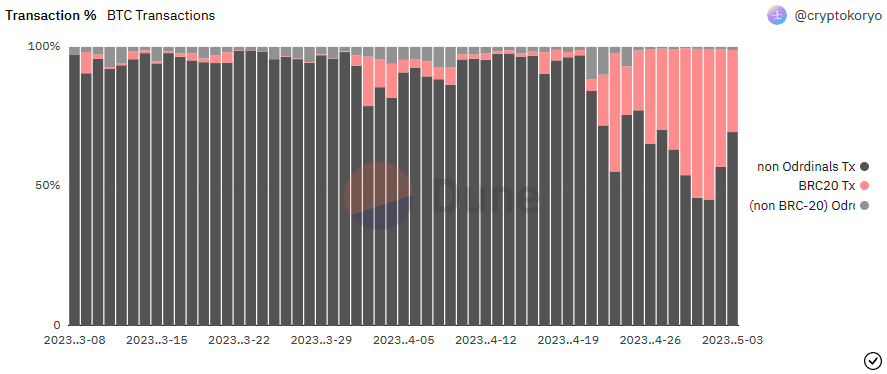The BRC-20 token standard of Bitcoin has gained significant popularity in the cryptocurrency ecosystem particularly in light of the recent surge of the Pepe ($PEPE) memecoin.
To date, approximately 8,500 unique tokens have been created using the BRC-20 standard, with memecoins like $PEPE and Memetic ($MEME) comprising the majority of these BRC-20 tokens.
The BRC-20 token standard is an experimental protocol on the Bitcoin blockchain that is inspired by Ethereum’s ERC-20. It enables developers to generate and transmit interchangeable tokens using the Ordinals protocol. The BRC-20 token standard was introduced in March 2023 by an on-chain analyst, who goes by the name Domo, to enable the issuance and transfer of interchangeable tokens on the Bitcoin blockchain.
Updated the gitbook to address common questions and my intentions for the experiment going forward.https://t.co/h6fksQ1oAe
— domo (@domodata) March 10, 2023
Although modeled after ERC-20, the BRC-20 token standard fundamentally differs from its Ethereum-based counterpart. BRC-20 tokens don’t make use of smart contracts. The token standard also requires a Bitcoin wallet to mint and trade these tokens.
Over the past month, and as of this writing, the market capitalization of BRC-20 tokens has experienced an explosive surge, currently standing at $120 million, which is a 600% increase in just one week.
The popularity of BRC-20 tokens is such that BRC-20 tokens are now taking a greater share of total transactions on the blockchain. Between April 29 and May 2 2023, the number of BRC-20 transactions accounted for over 50% of all Bitcoin blockchain transactions, outpacing regular BTC transactions.
Moreover, as a result of the increased activity involving BRC-20 tokens, transaction fees on the Bitcoin blockchain have also surged. Since late April 2023, the network has generated an additional 109.7 BTC in transaction fees for miners.
The BRC-20 token standard utilizes Ordinal inscriptions of JSON data to deploy token contracts, mint tokens, and transfer tokens.
Traditionally, the Ordinals protocol has been utilized to distribute and transfer ownership of digital assets such as images, videos, and audio files, each of which possesses unique characteristics that can be verified and are not interchangeable on a one-to-one basis.
However, the technology supporting Ordinals also permits programmers to embed text directly onto the Bitcoin blockchain. With the BRC-20 standard, this text is being utilized to symbolize interchangeable tokens that are essentially identical and can be exchanged on a one-to-one basis.
The screenshot above shows the text included in the transaction to create the “ordi” BRC-20 token (which is the top BRC-20 token by market capitalization at ~$8 million as of this writing).
As can be seen above, there is not much to a BRC-20 inscription.
- “p”: the tokens are being issued under the BRC-20 token standard
- “op”: the operation invoked in this transaction is to deploy or initialize the “ordi” tokens
- “tick”: the ticker of the tokens will be “ordi.”
- “max”: the maximum supply of “ordi” is 21,000,000 tokens
- “lim”: the maximum amount of “ordi” that could (theoretically) be minted in one transaction was capped at 1,000
The majority of BRC-20 tokens that have been created thus far can be categorized as ‘memecoins.’
As of now, approximately 3,400 distinct BRC-20 tokens have been generated, each with their own supply, which can range from the tens of millions to trillions. In total, the current market capitalization for all of these tokens combined is roughly $17.5 million.
The three most popular coins generated using the BRC-20 standard so far are:
- Ordi
- Pepe
- Meme
‘Ordi’ is an abbreviation for ‘Ordinals,’ while ‘Pepe’ is named after the popular Pepe the Frog meme which has been associated with the Bitcoin community since as early as 2016. Finally, ‘Meme’ is a reference to the concept of internet memes.
Follow us on Twitter for latest posts and updates
____________________________________
____________________________________












